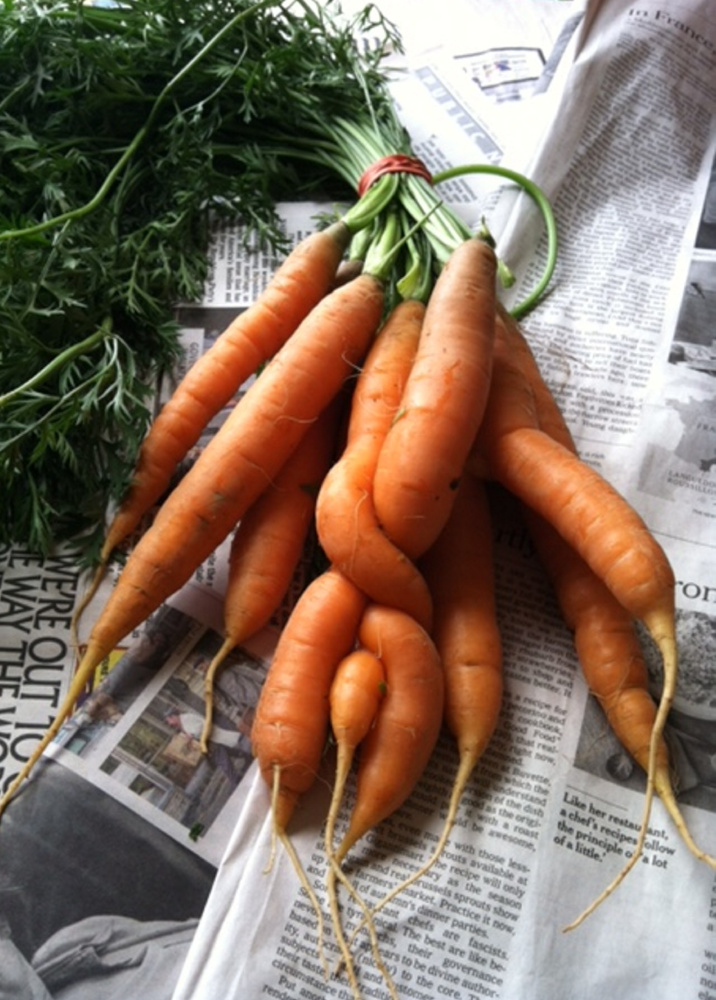Who is not amused by a two-legged carrot or an eggplant with a ski-jump nose? Gardeners don’t expect perfection or uniformity, especially when growing organically. Yet supermarkets claim they can sell only flawless produce that meets strict standards for size, weight, color, surface appearance and even “curvature” (no comment).
The U.S. Department of Agriculture sets standards for most fruits and vegetables, but the guidance is fuzzy and subjective. What exactly constitutes a “fairly well-formed” tomato?
Supermarket chains may adopt more stringent guidelines than the USDA, and can turn away produce that doesn’t pass their tests. Key concerns for retailers, Rochelle Bilow writes in Bon Appétit, are looks, longevity and transportability: “taste and nutrition don’t even make the list.”
Many farmers find that some of what they grow – as delectable as it may be – doesn’t fit the supermarket ideal. In the documentary film “Just Eat It” there’s a scene in which a grower – holding a fresh nectarine – says he can’t sell that fruit in the supermarket. The camera shifts to a huge funnel channeling a torrent of perfectly edible “reject” fruit into a dump truck. “As a grower,” he says, “that is heartbreaking.”
Who knew that so much culling occurred before produce ever reached the stores? The USDA does not track waste at the front end of the food system but anecdotal evidence suggests the volume is huge. By one estimate, more than half of the fresh fruits and vegetables grown in North America are never consumed. Individual farmers report that anywhere from 10 to 70 percent of their harvest goes to waste simply due to irregular shape and size or mild blemishes.
In a nation where 1 in 7 people don’t have reliable access to nutritious food, this practice defies reason. Tossing out millions of tons of edible food due to cosmetic imperfections “isn’t just bonkers,” chef Jamie Oliver observes, “it’s bordering on criminal.”
Rather than feeding hungry people, the “reject” produce is typically composted on site, plowed under or dumped in a landfill, where it decays, generating methane – a potent greenhouse gas. Transportation and timing challenges make it hard for growers to donate non-conforming produce to food banks or to sell it for processing or livestock feed.
Enterprises like Food Cowboy try to link suppliers with those who can convey produce to people in need but with perishable produce, matches must be made quickly.
Tristram Stuart, author of “Waste,” gathers produce for communal “Feeding the 5,000” meals with chef-led cooking demonstrations to show how delicious salvaged food can be. His nonprofit Feedback and other social media campaigns are elevating public awareness and pressuring stores to promote produce differently.
In 2014, the French grocery chain Intermarché began marketing Inglorious Fruits and Vegetables, unabashedly heralding the “ridiculous” potatoes, “ugly” carrots, “grotesque” apples, and “unfortunate” clementines that customers could purchase at a 30 percent discount. Store traffic increased by 24 percent, and the Inglorious items routinely sold out.
Now other chains are following suit, stocking and promoting these items as Produce with Personality (Giant Eagle), Naturally Imperfect (Canada’s Loblaws) and even Wonky Veg (UK’s Asda).
Just last month, Whole Foods and Hannaford announced pilot programs to market more homely produce – but not yet in Maine stores. Whole Foods is testing the concept in several California stores, and Hannaford in stores around Albany, New York.
Eric Blom, Hannaford’s external affairs manager, says the Misfits “product line” could reduce farm waste by giving growers a market for “less than perfect-looking” produce. He reports that the effort, while still new, has been “well received so far.” (The Misfits line will not affect Hannaford’s tradition of routinely culling its produce sections and sharing those items with regional food banks and pantries.)
Aesthetic challenges make fruits and vegetables more affordable and hence accessible – which could prove a big win for public health. As the film “Food Stamped” points out, junk food prices have declined while fruit and vegetable prices have spiked (a trend exacerbated by the California drought). Steeply discounted produce could encourage more consumers to make healthier food choices.
Relaxing the aesthetic standards for produce represents low-hanging fruit in the ongoing quest to eliminate food waste. There’s far more work that producers, retailers and consumers must do, much of it spelled out in U.S. Rep. Chellie Pingree’s proposed Food Recovery Act.
But for starters, let’s serve up wonky veggies. Eating imperfect produce could bring us closer to a perfect world where no one goes hungry.
Marina Schauffler is a writer who runs Natural Choices (naturalchoices.com).
Send questions/comments to the editors.


